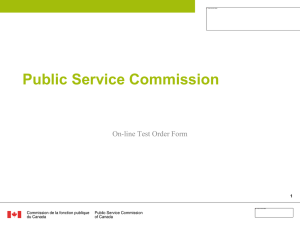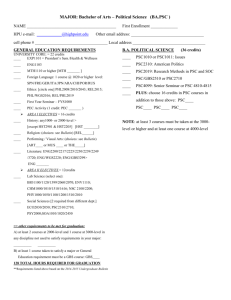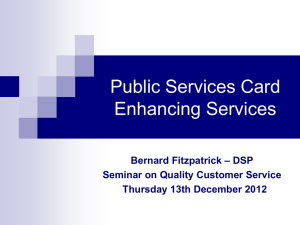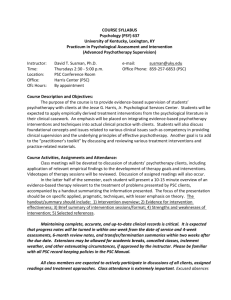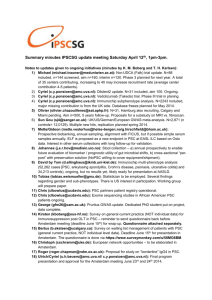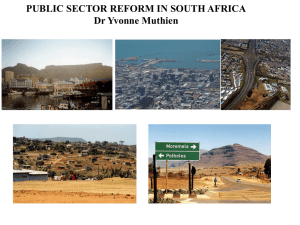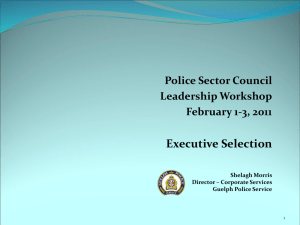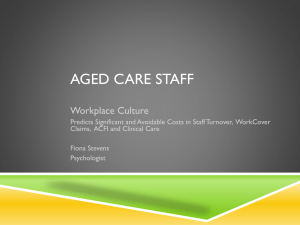Meeting minutes - Research at Oslo University Hospital
advertisement
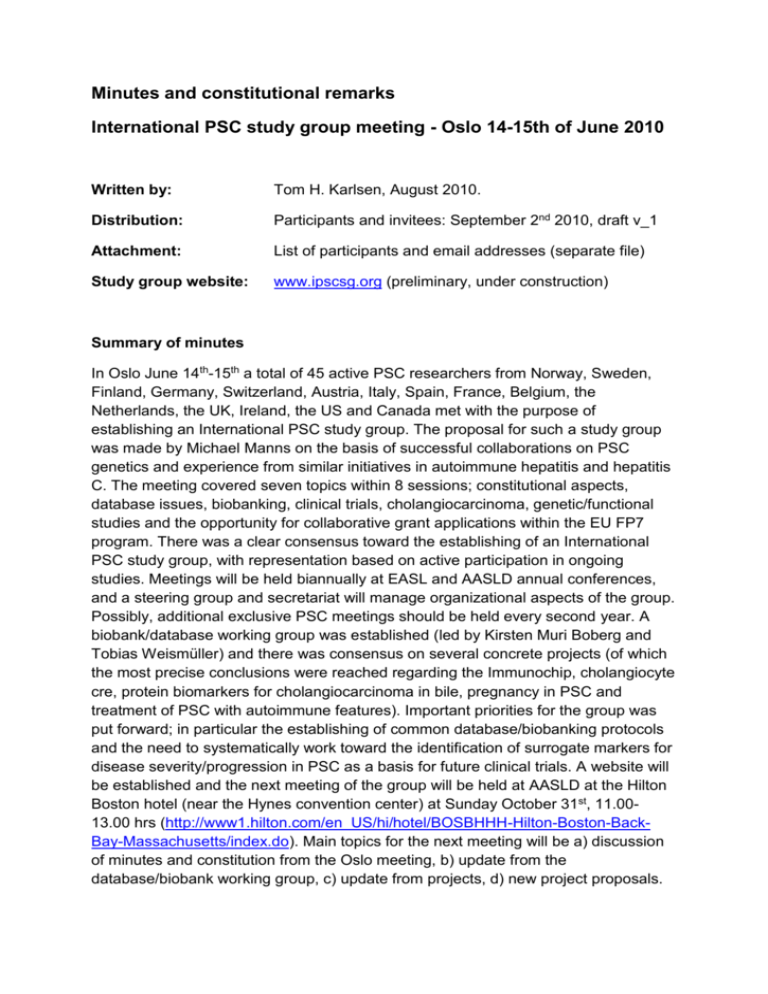
Minutes and constitutional remarks International PSC study group meeting - Oslo 14-15th of June 2010 Written by: Tom H. Karlsen, August 2010. Distribution: Participants and invitees: September 2nd 2010, draft v_1 Attachment: List of participants and email addresses (separate file) Study group website: www.ipscsg.org (preliminary, under construction) Summary of minutes In Oslo June 14th-15th a total of 45 active PSC researchers from Norway, Sweden, Finland, Germany, Switzerland, Austria, Italy, Spain, France, Belgium, the Netherlands, the UK, Ireland, the US and Canada met with the purpose of establishing an International PSC study group. The proposal for such a study group was made by Michael Manns on the basis of successful collaborations on PSC genetics and experience from similar initiatives in autoimmune hepatitis and hepatitis C. The meeting covered seven topics within 8 sessions; constitutional aspects, database issues, biobanking, clinical trials, cholangiocarcinoma, genetic/functional studies and the opportunity for collaborative grant applications within the EU FP7 program. There was a clear consensus toward the establishing of an International PSC study group, with representation based on active participation in ongoing studies. Meetings will be held biannually at EASL and AASLD annual conferences, and a steering group and secretariat will manage organizational aspects of the group. Possibly, additional exclusive PSC meetings should be held every second year. A biobank/database working group was established (led by Kirsten Muri Boberg and Tobias Weismüller) and there was consensus on several concrete projects (of which the most precise conclusions were reached regarding the Immunochip, cholangiocyte cre, protein biomarkers for cholangiocarcinoma in bile, pregnancy in PSC and treatment of PSC with autoimmune features). Important priorities for the group was put forward; in particular the establishing of common database/biobanking protocols and the need to systematically work toward the identification of surrogate markers for disease severity/progression in PSC as a basis for future clinical trials. A website will be established and the next meeting of the group will be held at AASLD at the Hilton Boston hotel (near the Hynes convention center) at Sunday October 31st, 11.0013.00 hrs (http://www1.hilton.com/en_US/hi/hotel/BOSBHHH-Hilton-Boston-BackBay-Massachusetts/index.do). Main topics for the next meeting will be a) discussion of minutes and constitution from the Oslo meeting, b) update from the database/biobank working group, c) update from projects, d) new project proposals. Summary of steering committee proposal: Prof. Michael Manns, Hannover, Germany Prof. Keith Lindor, Rochester, MN, US Prof. Peter Jansen, Amsterdam, the Netherlands Prof. Michael Trauner, Vienna, Austria Prof. Roger Chapman, Oxford, UK Secretariat representative, pt. Dr. Tom H. Karlsen, Oslo, Norway Summary of database/biobank committee proposal: Dr. Kirsten Muri Boberg, Oslo, Norway Dr. Tobias Weismüller, Hannover, Germany Prof. Alexander Knuth, Zürich, Switzerland Prof. Chantal Housset, Paris, France Prof. Olivier Chazouillères, Paris, France Dr. Cyriel Ponsioen, Amsterdam, The Netherlands Dr. Daniel Gotthardt, Heidelberg, Germany Dr. Christoph Scrhamm, Hamburg, Germany Dr. Brian Juran, Rochester, US Dr. Luca Fabris, Padua, Italy Prof. Dennis Black, Memphis, US Dr. Simon Rushbrook, Cambridge, UK Prof. David Adams, Birmingham, UK Prof. Martti Färkkilä, Helsinki, Finland Session 1: Constitution and prospects of an internation PSC study group Chairs: Michael Manns and Roger Chapman Presentations: Constitutional issues (online at www.ipscsg.org) Roger Chapman states that the basis of the opportunities faced by an international PSC study group is 30 years of research. The research aims of the group should be loose, yet the activity based on concrete scientific projects; a “talking shop” should be avoided. Michael Manns refers to PSC as the “black-box” of Hepatology: There is scarce knowledge on pathogenesis and no available therapy except for liver transplantation. The main challenges are related to analysis of basic data to come up with new ideas on therapy for clinical trials as well as investigation of the relationship with inflammatory bowel disease (IBD) and cholangiocarcinoma (CCA). Future clinical trials are needed and there is a need for consensus on endpoints for use in these trials. The low prevalence of PSC means it is difficult for single centers to answer all questions – leading to the initiative of the study group. Ansgar Lohse underscores that the constitution of the group and at all times should be defined by scientific questions. Erik Schrumpf emphasizes that a study group should be active when needed; some projects do not require the involvement of a study group. The point is supported by Alexander Knuth, who emphasizes that the dynamics of a study group should be project driven. Gideon Hirschfield suggests that establishing surrogate endpoints at the molecular level for clinical trials should be a major priority for a study group. Ansgar Lohse points to the importance of identifying prognostic markers to allow for the identification of surrogate markers. The topic is supplemented by Michael Manns who emphasizes the need also to define common inclusion criteria for clinical trials. Supported by Keith Lindor who emphasizes the need to define and understand subgroups of patients; the outcome of treatment trials may depend on the composition of the patient group. Stephen Pereira suggests that an important opportunity for a study group would be to establish collections of relevant biomaterial for studies and to define study populations for clinical trials. Supported by Johan Fevery referring to the heterogeneity of the disease and the need for collaborations to achieve sufficient numbers of subgroups of patients. Further supported by Alexander Knuth who suggests that a common database would facilitate the overview of material available for various types of projects. Erik Schrumpf points to cholangiocarcinoma in PSC as an example where urgent collaboration is needed for sufficient numbers of samples to become available for the many basic science initiatives running. Dennis Black underscores that it is important to include pediatric PSC in the study group activities, since the condition in many aspects differs from adult PSC. Dennis Black specifically points to the importance of following pediatric PSC patients into adulthood, and also describes the FDA funded UDCAdiscontinuation trial he is heading. The point is later supported by Stephen Pereira, who adds the topic of IgG4 associated sclerosing cholangitis. Einar Björnsson also emphasizes the need to include aspects related to diagnosis and management of IgG4 associated cholangitis. Erik Schrumpf also points to the usefulness of investigating the pathogenesis and distinct genetic susceptibility to well-characterized subgroups of patients, like IgG4 associated cholangitis. Peter Jansen suggests that in addition to the prospects for multicenter trials and collection of patients and material, there is an opportunity for the group to serve as a “think tank” for project opportunities in PSC. In that regard, basic science representation is important. The statement is later supported by Michael Manns who points out the relatively weak representation from basic science and the absence of pathologists at the study group startup meeting. The point is supplemented by Alexander Knuth who is the only representative from oncology, pointing out translational opportunities for a study group, in his case the topic of inflammation-associated cancer, which is of general rather than PSC specific importance. Michael Manns suggests that opportunities for funding for PSC oriented research should be a topic for an international PSC study group, particularly in the context of EU FP applications and NIH grants. Peter Jansen refers to the EASL support provided in conjunction with the successful NASH EU FP application and that similar opportunities should be explored for PSC. Kostas Lazaridis refers to his experience with the PROGRESS NIH grant application for a multicenter genome-wide association study in the US; the genetic collaborations could represent one opportunity for funding in a collaborative context. Michael Manns points to liver transplantation as another basis for grant applications, given the importance of PSC as an indication for liver transplantation in many European countries; in particular the issue should be emphasized vs. EASL. Keith Lindor points to collaborations on the development of proper animal models for PSC as an opportunity for funding and Ulrich Beuers refers to the work-shop on animal models in cholestatic liver diseases to be held at the upcoming AASLD. Roger Chapman suggests that collaborating with the IBD consortia may represent an important opportunity to obtain funding for PSC related projects. The latter point is further supported by Hugh Mulcahy who points to PSC representing many “difficult” aspects of gastroenterology, and that interventional aspects of the disease are closely linked with endoscopy and could perhaps be exploited for funding from private companies. Michael Manns supplements by pointing to the need to provide such companies with ideas and intellectual input for tool development, but also that “tool companies” typically have less resources available for funding than pharmaceutical companies. Michael Manns also points to oncology as a field where there could be funding opportunities for PSC. Michael Manns suggests that the PSC study group should be international – and groups from Asia and Latin America should be invited for representation. A discussion on the “membership” aspect of an international PSC study group balance between an exclusive / inclusive strategy. While an inclusive strategy is concluded, it is pointed out by several that membership and participation should primarily be based on project participation and active initiatives. Michael Manns points out that if the group becomes too big it may be difficult to coin the questions. Gideon Hirschfield points out that the national visibility for members of an international PSC study group could facilitate collaborative projects even within each country. A steering group should be concluded, a secretariat allocated and a web-site established (see final session). The chairs suggest that meetings should be held in conjunction with AASLD/EASL annual conferences, preferably in the middle of the event to allow for maximum attendance, and preferably short (e.g. including lunch) and at a “fixed time” from year to year. Peter Jansen confirms that EASL would support the allocation of such meetings, and suggests that they are held open (“PSC club”) even for non-members for participation (particular young scientists who otherwise would not get in contact with the PSC research community). Ansgar Lohse warns that making the meetings too short would make them non-decisive, and argues in the favor of dedicated meetings like the present meeting in Oslo and opens up for the possibility that the next meeting could be held in Hamburg in two years. Roger Chapman points out that a combination is possible, and that more dedicated meetings could be held with longer intervals, while still maintaining the momentum of frequent updates at EASL/AASLD. Peter Jansen suggests that a basic science workshop on PSC should be arranged at one point, and Ansgar Lohse suggests that another Monothematic/Single Topic Conference on PSC is also brought forward by the study group. Main conclusions of Session 1: - An International PSC study group should be established (IPSCSG) - Numerous collaborative opportunities were identified - IPSCSG should meet regularly during AASLD/EASL - Dedicated PSC meetings should also take place - Meetings should be open to those interested - Criteria for membership needs to be concluded at next meeting Session 2: International PSC database Chairs: Kirsten Muri Boberg and Tobias Weismüller Presentations: Chairs - The PSC database (online at www.ipscsg.org) Cyriel Ponsioen – EPIPSCPBC (online at www.ipscsg.org) Christopher Bowlus – Google (online at www.ipscsg.org) Christoph Schramm - pregnancy (online at www.ipscsg.org) The purpose of an international PSC database is discussed by the chairs. Identification of particular sub-groups (e.g. patients with cholangiocarcinoma, small-duct PSC etc.), to serve as a link and basis for sub-group analysis in relation to biobank material (e.g. DNA collections), to serve as a basis for epidemiological studies and possibly identify clinical risk factors. Ansgar Lohse supplements by emphasizing the possible importance of including histological parameters. The technical solution is brought up by the chairs. Kirsten Muri Boberg emphasizes that robustness, flexibility and durability are key points; data access requires careful consideration, but considerable experience exists within the study group from the local databases that already exist, the German HEPNET database and the Nordic liver transplant registry. Dennis Black describes the STOPSC database for PSC patient follow-up in the STOPSC consortium. The convenience of internet based data entry is emphasized, but there were also considerable costs. After the support from the Morgan family was discontinued (due to the financial crisis), the initiative has been restricted to the pediatric sub-consortium, which continues data entry with FDA support. Martti Färkkilä supports a web-based system by reporting on similar good experiences from the Finnish IBD database. Concerns versus a centralized database are raised on two holds: Gideon Hirschfield is concerned on costs. Alexander Knuth is concerned on ethical issues versus a centralized database. Kostas Lazaridis describes the local, standalone PROGRESS database as a preference. Keith Lindor and Cyriel Ponsioen describe an ideal database as a common “minimal form” which is provided on a centralized basis, with local responsibilities and additions based on project requirements. Tom Hemming Karlsen supports this type of initiative, which allocates ethical approval responsibilities locally, yet maintains collaborative opportunities based on common/uniform parameters/data. Stephen Pereira points out that ethical issues are more easily managed by maintaining patient IDs on a local basis only. Michael Manns supplements by underscoring that data should be stored at the local centers, but supports the concept of a “minimal common basis”. Ansgar Lohse states that the most important point is that local databases and the content can be linked / managed based on the common definitions. The level of details is extensively discussed with partly overlapping input from many participants. Dennis Black describes the STOPSC experience with a database with many details. Christoph Schramm emphasizes the need for completeness of parameters and also the need for a system for obtaining follow-up data. Kostas Lazaridis underscores that parameters should be defined based on the purpose with the database; a point which is further supported by Alexander Knuth who points out that the database should be shaped based on the scientific proposals to be pursued by the group. Peter Jansen supplements the point by emphasizing the need for a basis of specific scientific questions to obtain database funding. Christoph Schramm propose a specific, collaborative project related to pregnancy in PSC (for details and data registration forms, see www.ipscsg.org ) Kostas Lazaridis points to the need to ensure validity of data entries by consulting the patient records directly or by independent investigations. The point is supported by Cyriel Ponsioen who reports on several false positive cases of PSC in the Dutch “EpiPSCPBC” project. Kirsten Muri Boberg reviews the parameters of the database of the Norwegian PSC research center (see presentation at www.ipscsg.org for details). Michael Manns suggests that there is a need to include data on environmental factors; a reference is made to the PBC study of Prof. Gershwin. Kostas Lazaridis supports this initiative with reference to the PROGRESS database at Mayo. Christoph Schramm supports the point, but also warns against the difficulty of obtaining good and exhaustive epidemiological data. Ansgar Lohse emphasizes the need to include data on outcome to be able to define prognostic factors. Keith Lindor suggests that US evidence of portal hypertension should be included, leading to an emphasis of Dennis Black that in addition to definition of which criteria should be included, there is also a need to generate a consensus on how to detect/define these criteria (e.g. small-duct PSC). Erik Schrumpf emphasizes the need to include population based cohorts of PSC with reference to the EpiPSCPBC project and the probability that milder forms of PSC never seen at referral centers probably exist. Tom Hemming Karlsen supports the point with reference to the need to define the difference between these populations, possibly at the molecular/genetic level, but also to define the common features between all PSC patients, for which a mixed study population of population based and referral-based populations is acceptable. Chris Bowlus reports on the “Google Health” initiative undertaken in collaboration with the US “PSC partners seeking a cure” patient organization; this may serve as a tool for patient recruitment and aid in the identification of patients outside the urban areas and university hospital care. The point is further elaborated by Tobias Weismüller who is concerned on center bias in the context of identifying risk factors based on mixed international PSC database entries. The question of appropriate controls / matched controls is brought up by several participants. The discussion is inspired by the EpiPSCPBC presentation by Cyriel Ponsioen, where rigorous matching of cases / controls is undertaken. Kostas Lazaridis reports on similar efforts within the US PROGRESS initiative. Liesbet Henckaerts points out the pragmatic solution of recruiting the spouses as matched controls. Organizational issues and “responsibility” are brought up by Tobias Weismüller on behalf of the chairs. Key issues for discussion were local versus centralized responsibilities, link to local databases/ID, parameters to be included and management of data access for projects to data in the database. The consensus based on all discussions in the present session was to aim for “minimum” parameters to be defined by a working group and provided at the International PSC study group website (www.ipscsg.org). These criteria can be incorporated in existing local databases at different centers, but it was decided that an official, standalone database system with the criteria will be provided at the website (by the Norwegian PSC research center). Main conclusions of Session 2: - An international PSC database is recommended - The database should have a “minimal form” provided on a centralized basis and with local responsibilities and additions - The database should be stored locally - Kirsten Muri Boberg and Tobias Weismüller will prepare a proposal prior to next meeting Session 3: Clinical studies in PSC Chairs: Ulrich Beuers and Keith Lindor Presentations: Chairs – treatment review (available at www.ipscsg.org) Christoph Schramm – AIH/PSC (online at www.ipscsg.org) Cyriel Ponsioen – DILSTENT2 (online at www.ipscsg.org) Martti Färkkilä – liver transplantation (not available) The chairs introduce the challenges related to study design for clinical trials in PSC; key topics are inclusion criteria and endpoints. Ulrich Beuers summarizes the UDCA trials in PSC so far and presents the EASL and AASLD practice guidelines. Keith Lindor points to the usefulness of a study group for external validation of findings. Regarding inclusion criteria, Roger Chapman initiates the discussion by emphasizing the importance of distinguishing between the study of early versus late disease. The point is supported by Keith Lindor who suggest that the any target patient population is stratified prior to inclusion of patients. Ansgar Lohse and Keith Lindor further exemplify by pointing to IgG4 associated sclerosing cholangitis, and the difficulty of defining the group at the moment is discussed; uniform criteria for definition of this subgroup and other relevant subgroups of PSC patients are needed. Keith Lindor also suggests that stratification with regard to presence/absence of IBD and therapy for IBD may be necessary, and children should be managed separately (Dennis Black: cut-off at 18 years). Tom Hemming Karlsen points to the fact that the inclusion criteria may differ depending also on the mechanism of action of the drug to be studied, meaning “general inclusion criteria” applicable to any clinical trial may not be possible to define. Regarding endpoints, several suggestions related to surrogate markers for fibrosis and progressivity are brought up. Michael Manns suggests that the ideal endpoints for clinical trials in PSC are composite rather than “hard”, a point which is further supported by David Adams with reference to the fact that drug companies, in particular, want to know fast if there is “something going on” in response to drug administration. Ansgar Lohse brings up the importance of fibrosis measurements and the need to re-explore the utility of histology in staging of PSC. Gideon Hirschfield points to the difficulty of obtaining representative percutaneous biopsies with reference to ongoing gene expression profiling studies where they observe significant differences between hilar biopsies vs. diaphragmatic biopsies. The point on fibrosis is elaborated by Michael Manns with reference to Fibroscan, emphasizing that sonographic methods for fibrosis detection may not be appropriate for detecting fibrosis at the bile duct level. Martti Färkkilä points to the importance of distinguishing between the progression of cirrhosis versus the progression of a) the biliary fibrosis and b) development of cholangiocarcinoma. Keith Lindor points out that imaging methods should be explored for the purpose, including Magnetic Resonance Elastography (MRE) and MRC. Tom Hemming Karlsen suggests that surrogate endpoints for effects on disease status/activity may also vary depending on the mechanism of action for the drug under study, and that in some instances fibrosis markers may need to be supplemented with additional markers. Alexander Knuth and Kostas Lazaridis argue in the favor of establishing general markers for classification of “progressivity” in PSC. The point is supported by Keith Lindor, who argues in the favor of a classification system for identification of inherent “slow-progressive”, “medium progressive” and “fast progressive” disease. Ulrich Beuers suggests that lessons on the topic can be learnt from PBC, a point which is supplemented by Albert Pares who raises skepticism due to more variability in PSC and the occurrence of cholangiocarcinoma. Keith Lindor suggests that as a start the importance of ALP normalization in PSC nevertheless should be assessed, analogous to the categorization of responders/non-responders in PBC. Keith Lindor brings forward the problem of the ideal control group for future clinical trials – “low dose” UDCA or placebo? David Adams elaborates on the problems of defining “standard treatment” in light of the recent AASLD and EASL guidelines and the outcome of the high dose UDCA trial from Keith Lindor. On this background, Cyriel Ponsioen argues it impossible to offer UDCA in a non-inferiority design. Dennis Black describes the US pediatrics study, where patients are taken off UDCA (4 weeks of half the dose, 8 weeks off, 8 weeks on, then standard care), as an example of how to bypass the issue; outcome parameters in this study are clinical and inflammatory parameters. Several alternatives are proposed; Gideon Hirschfield argues in favor of a regular placebo control group given the lack of evidence for a beneficial UDCA effect; Erik Schrumpf argues in favor of including both UDCA and placebo controls; Ansgar Lohse suggest that patient compliance may be used to generate a control group, a point which is refuted by Ulrich Beuers who believes the strategy will include too many biases. Michael Manns supports the use of UDCA in the control group, since it otherwise will be difficult to find controls given current practice. The outcome of the high-dose UDCA trial is discussed. Roger Chapman argues in favor of an efficiency of low-dose UDCA and states that the issue on chemoprevention is still open. Keith Lindor questions not only an effect from UDCA on disease progression, but also a chemopreventive effect, based on the high-dose trial experience as well as the weaknesses of the previous retrospective data. Peter Jansen refers to novel data on vitamin A deficiency in the high dose UDCA group, suggesting mechanisms for the detrimental effects that could be compensated. Albert Pares enquires on the possibility that disease stage bias may have influenced these observations, but further analyses are needed to provide an answer. Three project proposals are launched (see above and www.ipscsg.org for PowerPoint presentations and details): o The project proposal of Christoph Schramm (“Inflammatory type of PSC” vs. immunosuppression) is most extensively debated. David Adams and Erik Schrumpf are sceptic toward a retrospective design, David Adams particularly points to the fluctuating course of inflammatory activity as a source of bias. Ansgar Lohse points to the difficulties in defining the entity based on recent findings by the IAIHG, and suggests that late stage patients are excluded. Michael Manns points to the appropriate management of the IgG4 sclerosing cholangitis entity within the study and suggests that portal activity on histology is the main inclusion criterion; it is also important to distinguish between prednisolone alone and prednisolone/azathioprine. Marco Marzioni raises concerns on risk of cholangiocarcinoma in a prospective design. David Adams brings forward the possibility of a regimen including rapamycin. o The project proposal of Cyriel Ponsioen (“DILSTENT2”) is discussed on the background of the EASL practice guidelines which are presented by Ulrich Beuers. o The presentation of Martti Färkkilä on uniform scoring systems for liver transplantation in PSC is discussed on the background of the MELD based organ allocation system. Main conclusions of Session 3: - Several challenges exist in clinical trials in PSC, definition of subgroups, endpoints and appropriate control groups - Cyriel Ponsioen will proceed with a protocol for stenting/balloon dilatations in PSC which is open for collaboration - Protocols for other studies are welcome Session 4: Genetic/functional studies in PSC Chairs: Arthur Kaser and Tom Hemming Karlsen Presentations: Tom Hemming Karlsen – PSC genetics (online at www.ipscsg.org) Arthur Kaser – cholangiocyte cre (online at www.ipscsg.org) Luca Fabris – cholangiocyte isolation (online at www.ipscsg.org) The presentation of Tom Hemming Karlsen initiates the discussion of the genetics/functional session. There have been comments during previous sessions that there is a need to include basic science topics on the agenda of a study group, and Tom Hemming Karlsen brings forward the opportunity for collaboration within issues related to ongoing genetic studies. The main topic of the presentation is the “Immunochip project” (http://www.immunochip.org.uk/) which is a custom array with approx. 200,000 single nucleotide polymorphisms (SNPs) found to be associated with other immune mediated diseases. Most of the loci found in these diseases are not unique for each of the phenotypes, rather general “autoimmunity genes” (see http://www.nature.com/nrg/journal/v10/n1/abs/nrg2489.html for further details on the concept). The characterization of which genes overlap between the different diseases may point to pathways of common translational interest between the various conditions. An example is the IL12 pathway identified in PBC by Gideon Hirschfield, a system for which biological therapeutics may already be available based on trials in other IL12-associated diseases like psoriasis and Crohn’s disease. As to the genetic susceptibility of PSC, multiple immune mediated genes are likely to be involved as well, and the application of the Immunochip to a large study panel, would enable similar “cross-over” reflections as well. Of interest among the genes identified so far is the IL2RA locus which was identified in the ongoing Scandinavian/German collaboration. The finding, along with the strong HLA association, is commented on by David Adams who points to the possibility that the primary factor driving bile duct injury in PSC may indeed be of an immunological nature. Participation in the Immunochip experiment is commented on in an organizational perspective and regarding authorships. There is broad consensus on participation from all countries represented, including novel patient panels from the UK, US, Canada, Finland and France. A total number of 4,000 patients is feasible. The Oslo group will cover all costs related to the PSC part of the project, and also manage logistic issues of the project. Analysis and writing will be done jointly by a working group consisting of participants from all major consortia, the UK, Germany, US/Canada and Scandinavia in particular. Possibilities on how to manage authorlists in the project are discussed; banner only (“The international PSC study group”) versus banner + actively contributing authors versus all authors listed. The intermediate solution is preferred by most participants and ends up the consensus; Michael Manns emphasizes that patient recruitment should be considered active contribution and that it is important for young investigators to have their efforts recognized by being listed fully. For the ones listed under the banner, a link to PubMed must be ensured, to make the contribution recognized as per the search engines. The timeline of the project is genotyping done by end of 2010, with the subsequent “PSC paper” preceding any “joint analysis” with the other immune mediated diseases participating (>225,000 DNAs will be genotyped in total in the project). Tom Hemming Karlsen emphasizes that the combined analysis, although PSC will only have a minor role, could still be the more important one for the ultimate characterization of genetic overlap with other immune mediated conditions. Since all loci potentially identified by the experiment have been previously reported, the initiative will not preempt ongoing GWAS initiatives in Scandinavia/Germany, the UK and the US, which should mainly focus on the identification of PSC specific loci. The “missing heritability” in the genetic studies of Crohn’s disease is commented on by Roger Chapman, emphasizing the need for further studies. Ansgar Lohse supplements by pointing to the limited role of present genetics in explaining pathogenesis. Arthur Kaser supplements by raising the role of gene-environment interactions as a possible explanation for missing heritability and a priority for research. The next stage of the discussion is represented by the presentation by Arthur Kaser on the proposal of developing a model for conditional knockout of genes in the cholangiocytes only (see presentation for details). The presentation is supplemented by the presentation by Luca Fabris, reviewing the extensive experience on the topic represented by the work of the groups of Luca Fabris and Prof. Strazzabosco. Luca Fabris also presents methodology for cholangiocyte isolation, which can be made available for a study group initiative targeted at the identification of a cholangiocyte specific promoter. Tom Hemming Karlsen supplements by emphasizing the concerns raised by Prof. Strazzabosco and Prof. Gores that such a promoter may very well not exist. The strategies for identifying a cholangiocyte specific promoter are discussed; Marco Marzioni warns against a strategy based upon cell-lines due to the change in expression profiles induced by the culturing. Marco Marzioni also points to the need to differentiate between small and large cholangiocytes and also consider other cell types (pancreatic cells, Langerhans cells, stellate cells etc.), and also raises technical concerns related to the anatomy of mice liver (multilobular). Arthur Kaser supplements by pointing to similar problems in rats. Chantal Housset raises the need to clarify further to which extent existing cre may cover many of the requested applications. Arthur Kaser elaborates on his experiences with the limitations of the K19 and albumin cres, supplementing Luca Fabris’ concerns regarding specificity for both these models. Gideon Hirschfield brings up the general topic of a need for animal model development in PSC. Gideon Hirschfield also points to the need for well- designed gene expression experiments as a step toward the identification of surrogate markers for disease activity and disease progression in PSC (see session 3). The point is supplemented by Chantal Housset who points to the importance of the identification of “severity” markers in PSC, possibly equally much so relevant as the identification of “susceptibility” markers. The point is further elaborated by Carlo Selmi, who suggests that data from multiple basic science sources need to be integrated to bring the understanding of pathogenesis and severity in PSC forward, not only genetic data and gene expression profiling, but also referring to his experience with epigenetic data. Gideon Hirschfield also suggests that these basic science data are taken forward for evaluation in the context of “molecular phenotyping” and novel ways to classify patients. David Adams states an interest from the side of Birmingham to participate in the efforts, and suggests that the basic science issues could be taken forward by a basic science working group within the International PSC study group, but no consensus on a specific constitution of such a group is reached. Main conclusions of Session 4: - The participation in the “Immunochip project” was agreed upon. - General principles of authorship were agreed upon - The need for appropriate animal models for the study of pathogenesis in PSC was stressed. Session 5: Cholangiocarcinoma Chairs: Jochen Wedemeyer and Stephen Pereira Presentations: Jochen Wedemeyer – introduction (online at www.ipscsg.org) Stephen Pereira – trials (online at www.ipscsg.org) Michael Manns – proteomic markers (not available) Daniel Gotthardt – proteomic markers (not available) Kirsten Muri Boberg – biobanking (online at www.ipscsg.org) The discussion is initiated by Jochen Wedemeyer presenting the Hannover protocol for cholangiocarcinoma surveillance. Roger Chapman and Erik Schrumpf comments on the lack of validated tools and evidence for the various surveillance strategies that can be proposed. Ansgar Lohse supplements by emphasizing the problem of randomizing patients in surveillance program studies – first there is the problem of actual predictive values for the initiatives in such studies, second there is the problem of consequences on detection of malignancy (transplantation programs vary). Stephen Pereira suggests that the first step is to focus on the development of appropriate tests for the topic. Jochen Wedemeyer suggests that consensus protocols for cholangiocarcinoma detection could be made available at the website. Due to lack of evidence for any protocol, Chris Bowlus warns against making such statements available on the internet and emphasizes that the issues need to be explored in the context of studies before a consensus can even be made. Ulrich Beuers and David Adams specify the latter by pointing to the need to establish protocols that would identify the patients who are candidates for liver transplantation. Jochen Wedemeyer also brings forward the issue on whether there should be initiatives to evaluate other liver transplantation protocols than the one from the Mayo clinic, but there is no consensus in the group on the topic. Ansgar Lohse brings the discussion in the direction of establishing common protocols for sampling biomaterial for biomarker studies. Michael Manns presents the Hannover bile proteomic project, where previously unknown markers for differentiating PSC vs. CCA (AUC 0.8 in present setup) have been identified. Daniel Gotthardt presents the Heidelberg bile proteome project which conceptually has followed a slightly different path, emphasizing that a panel/combination of multiple markers is likely to be required to adequately differentiate PSC from CCA, since the inflammatory processes in PSC easily may influence single markers of apparent utility. The bile in both projects had been sampled at ERC, 500-1000ul without contrast. Both groups request collaboration within the study group to provide adequate numbers of patients with PSC and CCA. Erik Schrumpf encourages collaboration, but requests further information on the influence of cancer stage on findings, and is supplemented on the point by Christoph Schramm who points to the usefulness of establishing protocols on the topic. The concept of a “biomarker group” within the study group is discussed, but no consensus is made and the topic is revisited in the separate session on biobanking. Tom Hemming Karlsen asks on how to manage multiple requests for biomaterial support from the Oslo biobank on seemingly overlapping/identical projects. Michael Manns emphasizes that there is room for several initiatives, not least due to the importance of external validation, and that samples from particular resources within the study group can and should be provided for multiple projects. Stephen Pereira points to the usefulness of a study group for conducting trials by referring the cisplatin/gemcitabine study (article found at http://www.nejm.org/doi/full/10.1056/NEJMoa0908721). Stephen Pereira also presents the resources represented by biomaterial collections within the UK TRANSBIL and UKCTOCS studies. The presentation is supplemented by Kirsten Muri Boberg, who presents practical experiences (obstacles) on managing collaborations which are based on the “precious resource” represented by tissue samples from cholangiocarcinomas, particularly in the context of PSC. Dennis Black proposes that an ancillary study group committee could advice on the usage of such material within the collaboration, but the topic is not concluded. Stephen Pereira underscores that the initial focus should be on establishing uniform/common standard operating procedures (SOPs) for material collection and that the SOPs should be put on the study group website. Main conclusions of Session 5: - Common biobanking protocols (SOPs) should be established - Exchange of bile for proteomic studies in Heidelberg and Hannover will take place within the study group Session 6: Biobanking Chairs: Alexander Knuth and Martti Färkkilä Presentations: Chairs – background (online at www.ipscsg.org) Arthur Kaser – mechanistic studies (online at www.ipscsg.org) Brian Juran – PROGRESS (online at www.ipscsg.org) Carlo Selmi – call for PSC twins (oral appeal only) The discussion is initiated by the chairs presenting background information on opportunities for biobanking within the study group (see PowerPoint file for details). Alexander Knuth directs the emphasis of the discussion in the direction of establishing common SOPs and possibly also an open registry to provide an overview of which types and which amount of material that can be made available for collaborations within the study group. Tom Hemming Karlsen points out the overlap with the challenges faced by the database group, suggesting that further work on the topic is managed by a single “focus group” on biobanking and database. Alexander Knuth points to the usefulness of common material transfer agreements to ensure legal and ethical aspects of material exchange within the study group and between the individual centers. Ansgar Lohse raises concern on biobanking without a priori aims or scientific topics. Kirsten Muri Boberg supplements by emphasizing the need to ensure the suitability of material collected for novel methodologies and that this aspect needs to be incorporated to make an initiative sensible in the long term perspective. Alexander Knuth raises the proposal that communication and an overview of the material is coordinated by a “central office”. Erik Schrumpf is skeptical versus a “centralized” biobanking infrastructure and prefers decentralized responsibilities. Chris Bowlus argues in favor of an intermediate solution, and Alexander Knuth argues in favor of a “bank account” where it would be possible for participants in the study group to gain an impression of whether material for a project initiative may be available. Kirsten Muri Boberg emphasizes that the use of common protocols of course must remain “voluntary” for the study group members. Liesbet Henckaerts raises the issue of how to manage any subsequent heterogeneity of sample collection and preparation, and Alexander Knuth emphasizes that all management and shipment details must be registered for samples collected within the study group. Alexander Knuth suggests that involving pathologists in the biobanking initiatives would greatly facility material access. The proposal is supported by Michael Manns, who suggests that diagnostic biobanks should be utilized and included in the planning of biobanking within the study group and made available for material exchange programs in particular projects. There is consensus on the establishing of a joint database / biobanking group, led by Kirsten Muri Boberg and Tobias Weismüller and consisting of the following additional members: Alexander Knuth, Cyriel Ponsioen, Daniel Gotthardt, Christoph Schramm, Brian Juran, Luca Fabris, Dennis Black, Simon Rushbrook, David Adams and Martti Färkkilä. Main conclusions of Session 6: - A database/biobank committee was established, and consists of Kirsten Muri Boberg, Tobias Weismüller, Chantal Housset, Olivier Chazouillères, Alexander Knuth, Cyriel Ponsioen, Daniel Gotthardt, Christoph Schramm, Brian Juran, Luca Fabris, Dennis Black, Simon Rushbrook, David Adams and Martti Färkkilä. - SOPs for biobanking will be generated by the database/biobank committee - SOPs for biobanking will be made available at the IPSCSG website Session 7: FP7 opportunities Chairs: Michael Manns and Christoph Schramm Presentations: Christoph Schramm – background (online at www.ipscsg.org) Marco Marzioni – experiences (online at www.ipscsg.org) Christoph Schramm has reviewed the opportunities within the FP7 program for an application driven by the study group. The most promising opportunity following a discussion on all suggestions seems to be a call for rare diseases 10/2011. The proposal is supported by Marco Marzioni who emphasizes the need to carefully select the call into which effort should be invested. Marco Marzioni presents his experience with the cholangiocarcinoma FP7 application (see PowerPoint file for details). Financial aspects and the need to involve enterprises were emphasized given the purpose of the program not only to develop science, but also EU economy. Exploitation of results from the project needs to be elaborated for the same reasons. There should be as many EU participants as possible to capture the aims of the program related to EU integration, but not too may per country. The deliveries from the project should be time-wise distributed, and there always must be a contingency plan on how to cope if things do not work out the way they were intended to. Finally, it is crucial to involve expert managing companies, who will assist in terms of professional management, writing/structuring and networking. Erik Schrumpf supplements the presentation by emphasizing the amount of work required – not only during the application itself – but also related to project management and reporting bureaucracy. Michael Manns emphasizes the opportunities for EASL support in the process of an application – both financially, but also related to inevitable lobby activities. Michael Manns also suggest that aspects related to PSC epidemiology in Southern Europe needs to be incorporated in the proposal. Pietro Invernizzi supports the rare disease call, and emphasizes that all aspects of the disease must be covered. Alexander Knuth and Ansgar Lohse emphasize that the work needs to be initiated as soon as possible, even for the 2011 call, and suggest that a focus group on the topic should be established which represents all centers interested in participation. The application proposal should subsequently be built around the activities represented by these centers. An early initiative should be to include commercial companies in the opportunities that may be related to the outcome and activities of the project proposal. There is consensus in the group on proceeding vs. the rare disease call in FP7, but the discussion on distribution of responsibilities needs to be concluded at a later stage. Christoph Schramm has some interest in taking on the lead, and multiple others are interested in contributing, but no decision can be reached ad hoc on the composition of a working group. Main conclusions of Session 7: - A grant application within the EU FP7 program should be made, probably under the leadership of Christoph Schramm Session 8: Constitution and future IPSCSG meetings Chairs: Michael Manns and Erik Schrumpf Presentations: Relates to presentation of session 1 (online at www.ipscsg.org) There is consensus to meet regularly at EASL / AASLD (se Session 1). In addition to this, there is a wish for more dedicated meetings, and Ansgar Lohse opens up for the possibility of a meeting in Hamburg in 1-2 years. There is consensus on a steering group consisting on Michael Manns, Peter Jansen, Prof. Trauner, Keith Lindor, Roger Chapman and the secretariat. A complete email list will accompany the minutes. The minutes will be reviewed closely by all participants and concluded at next meeting. There will be a secretariat of the group which for a start will be allocated to the Oslo group. The Oslo group decides that Tom Hemming Karlsen will manage the secretariat functions. The secretariat will be represented in the steering group. Michael Manns summarizes the meeting, pointing to the most immediate opportunities; database/biobanking, the FP7 rare diseases application, the genetic projects, opportunities related to transplantation, collaborations with the IBD consortia and the pharmaceutical industry, the pregnancy and twin studies, the studies related to cancer – both biomarker (e.g. Hannover/Heidelberg bile studies) and the inflammatory aspects of cancer in PSC, the need to involve pathologists and oncologists and - ultimately - the need for the group to publish from the collaborative efforts - with all members being identified in PubMed in cases where a banner authorship is required.
